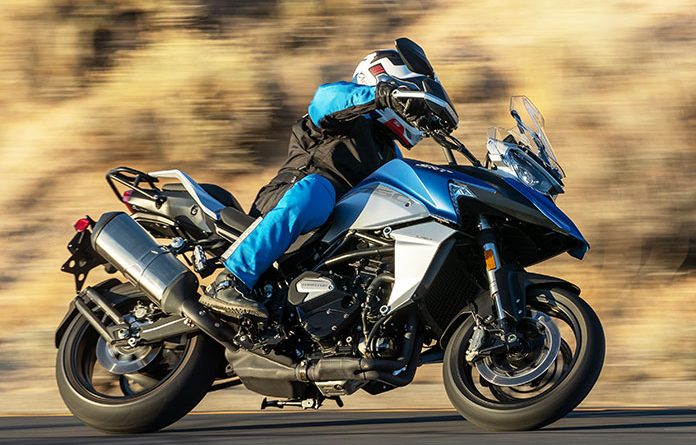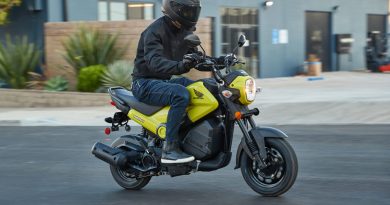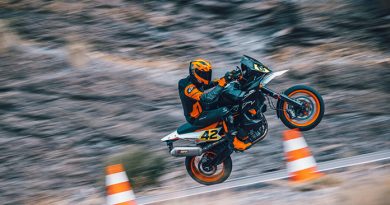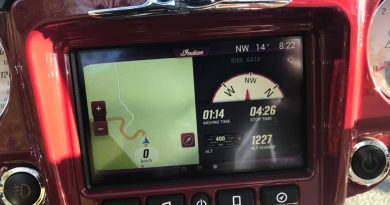2023 QJ Motor SRT750 | Road Test Review
QJ Motor isn’t exactly a household name here in the U.S., but given the Chinese company’s global ambitions, that may soon change, especially with the 2023 QJ Motor SRT750.
QJ Motor is an enormous manufacturer that produces millions of motorcycles, scooters, engines, parts, and more every year, and it exports a fair share of its products from China to 130 countries. Since the motorcycle division’s launch in 1985, QJ Motor (Zhejiang Qianjiang Motorcycle Co. Ltd.) has also partnered behind the scenes with several familiar motorcycle OEMs here and abroad to make some of their engines, key components, and even complete motorcycles.
In 2005, QJ Motor acquired the name and assets of the 100-year-old Italian company Benelli, which has helped it grow market share in Europe and America. The company maintains a design center in Italy to give its two-wheelers some European flare, and it has manufactured an extensive line of Italian-designed, Benelli-badged modern motorcycles in China since 2008.
So far, QJ Motor’s only public foray into the U.S. has been with the Benelli lineup, which is sold by Southern California-based importer SSR Motorsports. SSR also offers its own line of dirtbikes and small street and dual-sport machines through its national network of motorcycle dealers.
Having tested the waters in the U.S. with Benelli since 2016, QJ Motor will brave the fickle American market in 2023 with its house brand, once again through its faithful partner SSR. Although the domestic QJ Motor lineup comprises more than two dozen motorcycles, scooters, and electric bikes, the first to make landfall here will be the 2023 QJ Motor SRT750, capitalizing on the current popularity of adventure-styled machines.
The Benelli/QJ Motor team in Italy based the SRT750’s overall design on the Benelli TRK502 adventure bike. It blends a classic ADV beak and seemingly giant fuel tank – really just 4.9 gallons – with an open trellis frame, exposed engine, and swoopy tailsection. The SRT750 may be the right bike at the right time given current market conditions – particularly because its $8,499 price tag is quite appealing when compared with similar adventure-styled motorcycles from Japan and Europe.
Related: 2021 Benelli TRK502X | Road Test Review
Tested here in preproduction form, the 2023 SRT750’s final price, specifications, and equipment may change a bit before it hits dealer showrooms this spring. While the bike may eventually be offered in off-road-ready adventure guise as well, the lighter sport version we tested has cast aluminum wheels and Pirelli Angel GT sport-touring tires instead of heavier spoked wheels and dirt-ready buns. While the lack of tubular guards and bash plates certainly saves weight, the SRT750 still tips the scales at a rather heavy 552 lb for a bike in this displacement class.
In keeping with the trend in the middleweight adventure class toward compact parallel-Twins that are simpler and cheaper to build than V-Twins, the SRT750 is powered by a 754cc Twin with liquid cooling, DOHC, 4 valves per cylinder, Bosch EFI, 6 speeds, and chain final drive. Not much to get excited about – until you start it up, at which point the engine’s 270-degree crankshaft creates a growling drumbeat idle reminiscent of a performance-tuned 90-degree V-Twin. Closing my eyes at a stop, I could swear I was sitting on a Ducati.
With better engine balance than a 360-degree crank, less rocking couple than a 180, and the same firing order as a V-Twin, a 270-degree crankshaft offers more character without a large sacrifice in power – hence its use in so many late-model parallel-Twins. In almost all cases, including the SRT750, vibration that would otherwise result from the uneven firing order is kept at bay by a gear-driven counterbalancer shaft.
On Jett Tuning’s rear-wheel dyno, the SRT750 made 70.5 hp at 8,600 rpm and 46.6 lb-ft of torque at 7,800, solid peak numbers that are comparable to, say, the Suzuki V-Strom 650. This gives the bike brisk acceleration that most solo riders will find more than exciting enough in the canyons and on the highway, especially since the power is delivered with an Italian operatic bark and great twin-cylinder feel. As long as you’re not in too big a hurry, the engine provides adequate urge when the bike is fully loaded too.
Throttle response is smooth and linear up to the actual rev limit at 9,300 rpm (the tachometer is redlined at 10,000), except just off idle and up to about 3,000 rpm, where the rough power delivery needs some refinement, particularly if the rider wants to tackle any tricky low-speed terrain where smooth throttle modulation is critical. Cruising along at an actual 60 mph (measured with GPS – the bike’s speedometer read 10-12% high, but its tripmeter was accurate), the engine turns over a smooth, leisurely 4,500 rpm. As speed and engine rpm climb above 6,000 rpm or so, a little vibration creeps into the grips, but it’s not bothersome.
Like its clean, rugged styling, simplicity is a welcome feature of the SRT750. Other than the 5-inch color TFT display with adjustable day/night modes, gear indicator, and both Bluetooth and TPMS connections (for a future smartphone app and tire pressure sending units, perhaps?), the bike gets by without many bells and whistles. Lighting is all LED, including the bright twin-beam headlight and nicely faired-in front turnsignals with clear lenses, and there’s a USB port right by the ignition switch. Brake and clutch levers are adjustable, aluminum braced handguards are standard, and extra buttons on each switch pod are ready for optional heated grips and fog lights.
QJ Motor says it may also add a centerstand and tubular engine/fairing guards as standard equipment, though personally I would save the latter for the adventure version. Don’t look for riding modes, traction control, or windscreen adjustability, though the SRT750 does include some useful storage under the locking seat, easy battery access, right-angle valve stems, shapely passenger grabrails, and a handy top trunk/luggage rack. If the DOHC valve train inspection every 15,000 miles reveals that the shim-under-bucket lash needs adjustment, the camshafts may need to come out, but there’s nothing unusual about that or the rest of the SRT750’s maintenance needs.
At 32.9 inches, the SRT750’s nonadjustable seat height is reasonable, though the pillion perch is much higher, so take care not to bash your knee on a passenger grabrail when swinging a leg over. With my 29-inch inseam, I found that, once seated, I could touch my feet down and paddle the bike around easily, and the cleated footpegs with vibration-damping removable rubber inserts are nicely positioned under the rider’s seat. When we first got the SRT750, its wide, tapered tubular handlebar was adjusted well up and forward, like you might position it to accommodate standing while riding off-road.
Although the bike’s ergonomics work well sitting or standing, its Pirelli Angel GT sport-touring tires, a 17-inch front wheel, and no tip-over protection indicates that this model is meant for the blacktop. But spoon on some 50/50 tires and you could certainly tackle dirt roads and gentle trails (though its limited suspension travel and ground clearance are unlikely to enhance the experience).
Read all of Rider’s Adventure & Dual-Sport Motorcycle coverage here
Once adjusted back down, I found the reach to the handlebar and grips easy enough but still a little farther away than I like, and the otherwise comfortable seat tended to slide me forward into the tank. Wind protection is just fair since the nonadjustable screen is only mid-sized and positioned well forward, which lets the noisy windblast roll down in front rather than over the rider. The lower body and upper legs are mostly tucked in snugly behind the tank and fairing lowers, and the handguards are quite effective at blocking the cold. The TFT display is bright and easy to read, and all the handlebar switches and buttons – some of which are nicely backlit – come readily to hand.
Since it’s a preproduction model, I gave the SRT750 a thorough going-over before riding off the first time, particularly the KYB suspension. A 43mm inverted fork with adjustable spring preload and rebound damping does a nice job up front, with its 6.1 inches of travel resisting excessive dive and offering a compliant but sporty feel over bumps and under braking.
With no progressive linkage, the rear shock is a disappointment. Even after you make the effort to adjust its unwieldy ring-and-locknut spring preload for the rider’s weight, a bumpy road will quickly overwhelm the shock. The bike’s handling is sensitive to rear spring preload adjustment – too much and it turns in too quickly, too little and it suffers from some squirminess in front. All the more reason it should have a remote spring preload adjuster rather than just a knuckle-busting ring-and-locknut, particularly if your load will change frequently. The slotted clicker rebound damping adjuster is easily accessed and helps fine-tune the ride in back, but if this were my bike, I’d swap out the shock for a higher-quality damper.
With its wide handlebar, compact wheelbase, steep rake angle, 17-inch wheels, and sticky tires, the SRT750 eats winding roads for breakfast, with an assist from its torquey midrange that helps it power out of corners and squirt from turn to turn. Regular and deliberate shifting helps keep the engine in the meat of the powerband and out of the juddery low-rpm zone where the fueling needs some work. But the 6-speed transmission and slip/assist clutch work smoothly, and shift lever throw is moderate. On the highway, it’s a comfortable companion that will cruise along at 75 mph from fill-up to fill-up, with only the noisy windscreen and lack of rear suspension performance over repetitive bumps to detract from the experience.
Impressive-looking radial-mounted Brembo 4-piston brake calipers clamp large floating dual front discs and bring the SRT750 to a halt smoothly and quickly, with a Brembo radial-pump master cylinder that gives the front brakes excellent feel at the adjustable lever. Surprisingly, the rear caliper is a nice opposed 2-piston Brembo rather than an economy 1-piston pin-slide unit, and it does a great job as well, with the pedal well-positioned directly below the ball of the foot. Overall, the brakes make for a fairly carefree riding experience, especially since they’re backed up with ABS that works smoothly and reliably when engaged. Unfortunately, the ABS can’t be turned off or adjusted, a consideration if you plan to hustle the bike around off-road.
To build the SRT750, QJ Motor has sourced quality components from around the world and integrated them into a solid package with great fit and finish, designed in Italy and manufactured in a modern, ISO9001-certified factory in China. It’s worth a look for far more than just its lower price – the bike is a blast to ride, and with nearly 400 SSR Motorsports dealers around the U.S., support for the QJ lineup should be adequate.
With a better rear shock and a taller aftermarket or accessory windscreen for colder weather, I wouldn’t hesitate to slip some soft luggage on the SRT750 and take off on a cross-country ride, especially since it sips fuel when ridden conservatively. You could also pop on some 50/50 tires, bash bars, and a skid plate for that exposed oil filter and whatnot underneath and knock the rubber inserts out of the footpegs, and it would be ready for light adventure riding. Or just leave it as-is, in sport mode, and wait for an adventure version of the SRT750 to arrive with all of that and a 19-inch front wheel. At this price, many riders would find it easy to own both.
2023 QJ Motor SRT750 Specs
Base Price: $8,499
Warranty: 1 yr., 12,000 miles
Website: Motor.QJMotor.com
ENGINE
Type: Liquid-cooled, transverse parallel-Twin, DOHC w/ 4 valves per cyl.
Displacement: 754cc
Bore x Stroke: 88.0 x 62.0mm
Compression Ratio: 11.5:1
Valve Insp. Interval: 15,000 miles
Fuel Delivery: Bosch EFI
Lubrication System: Wet sump, 3.0 qt. cap.
Transmission: 6-speed, cable-actuated slip/assist wet clutch
Final Drive: Chain
CHASSIS
Frame: Tubular-steel trellis w/ engine as stressed member, cast aluminum swingarm
Wheelbase: 60.6 in.
Rake/Trail: 25 degrees/5.3 in.
Seat Height: 32.9 in.
Suspension, Front: 43mm inverted fork, adj. for spring preload & rebound damping, 6.1 in. travel
Rear: Single shock, adj. for spring preload & rebound damping, 2.0 in. stroke (travel NA)
Brakes, Front: Dual 320mm discs w/ opposed 4-piston radial calipers, radial master cylinder & ABS
Rear: Single 260mm disc w/ opposed 2-piston caliper & ABS
Wheels, Front: Cast aluminum, 3.50 x 17
Rear: Cast aluminum, 5.50 x 17
Tires, Front: Tubeless radial, 120/70-R17
Rear: Tubeless radial, 180/55-R17
Wet Weight: 552 lb
Claimed Load Capacity: 332 lb
GVWR: 884 lb
PERFORMANCE
Horsepower: 70.5 @ 8,600 rpm (rear-wheel dyno)
Torque: 46.6 lb-ft @ 7,800 rpm (rear-wheel dyno)
Fuel Capacity: 4.9 gal
Fuel Consumption: 36.3 mpg
Estimated Range: 178 miles
The post 2023 QJ Motor SRT750 | Road Test Review first appeared on Rider Magazine.





